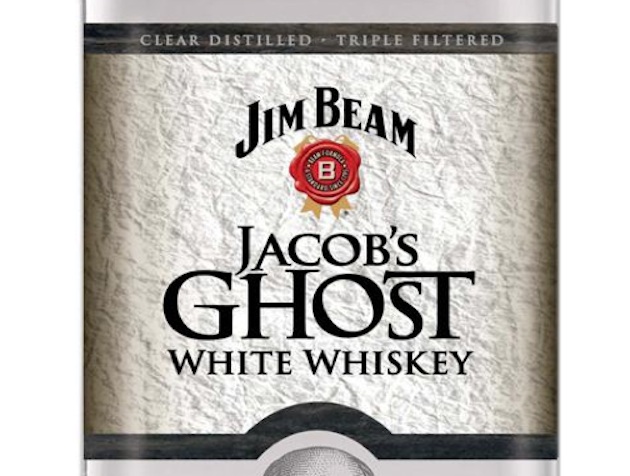
White whiskey could perhaps be one of the most contentious segments of the whiskey market. The definitions of what some call a white whiskey are often nebulous, as the folks over at Jack Daniel’s found out when the TTB classified their Jack Daniel’s Unaged Rye as a “neutral spirit.” For Jim Beam, the term “white whiskey” is used in the truest sense. Jim Beam Jacob’s Ghost is indeed whiskey: it’s the same mashbill that is used to make Jim Beam White Label Bourbon and it has been aged for at least one full year in charred, white oak barrels, so labeling it whiskey is correct. After a year, Jacob’s Ghost does have a distinct color, but Jim Beam transforms that whiskey into a white whiskey through a filtration process that results in a nearly clear spirit. This puts Jacob’s Ghost in a much different space from most of the other white dog/white whiskey on the market.
Jim Beam Jacob’s Ghost (80 proof / 40%, $21.99) is pale gold in color. It might be more aptly named “off-white whiskey” but the color is so faint, when you get it in a glass (especially with ice), it looks white. The nose of Jacob’s Ghost makes it clear that it has spent time in a barrel, with light oak tones combined with sweet corn, vanilla, light cereal grains, and a slight briny note. The nose has a slight spicy quality to it which may be from the young rye and barley in the mash, as well as its time in oak. The nose isn’t as inviting as Jim Beam White Label and significantly less inviting than a young corn whiskey like Glen Thunder.
The entry of Jacob’s Ghost is light, sweet vanilla with corn and cereal grains underneath (think vanilla Cheerios). Things don’t change much in the midpalate where the vanilla transitions into a honeyed vanilla. We pick up a slight oak spice toward the end of the midpalate which drives a very dry finish. The mouthfeel of Jacob’s Ghost is quite pleasant, except for the finish, which is too dry. This extremely dry finish makes sipping Jacob’s Ghost neat problematic. Putting it over ice helps, but for a neat sipper we’d still go with Jim Beam Black. Because of its light qualities, Jacob’s Ghost doesn’t have the structure to really stand up as well as Jim Beam White Label in Coke, where it gets kind of lost in the mix.
Jacob’s Ghost’s aspirations may be more in the cocktail space than as a spirit to drink neat or with a simple mixer. Jacob’s Ghost does mix well and stands in for vodka in a Bloody Mary (which becomes a Brown Mary or Whiskey Mary). Jacob’s Ghost also works well as a stand in for vodka in a Moscow Mule, makes a good Whiskey Sour, but struggles to stand in for tequila in a Margarita because it’s too dry to balance out the lime. Surprisingly, Jacob’s Ghost is at its best as a stand in for vodka in the all too common vodka soda. With soda (and a twist of lemon, lime, or both), Jacob’s Ghost brings enough character and flavor to the table to help elevate the drink from its otherwise bland status. In this space Jacob’s Ghost could become a serious contender for vodka drinkers looking to step up to whiskey, or for people who drink whiskey but honestly don’t love it.
One of the things we aren’t crazy about with Jacob’s Ghost is the price. A 750ml bottle of Jim Beam White Label, which is aged at least 4 years, retails for $15.99, and yet Beam has priced this 1 year old product at $21.99. It’s hard to justifly a full $6 upcharge for a product that has less age on it and comes from the same mashbill. That said, pricing is often set on what people will pay for it, and at $21.99 it’s still not the unbelievable price gouge that Jack Daniel’s Unaged Rye is, and Jacob’s Ghost sits pricewise along with Black and Devil’s Cut.
In some ways Jacob’s Ghost is the flip side of the coin from Jim Beam’s Devil’s Cut. Rather than pumping up the oak, Jacob’s Ghost reduces the impact of the barrel on the whiskey and creates a spirit that is light, dry, and easy to drink, especially with soda.
Jacob’s Ghost is set to hit retail in early 2013, beginning in major US markets in January and February, and then nationwide by the spring.